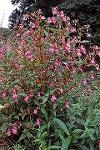Plants
Himalayan Balsam

Himalayan balsam (Impatiens glandulifera) grows rapidly and spreads quickly, smothering other vegetation as it goes.
Under no circumstances should Himalayan balsam be disposed of in your green garden or blue recycling bins.
Between June and October it produces clusters of purplish pink (or rarely white) helmet-shaped flowers. The Himalayan reaches well over head height at 2-3m (6-10ft)and is a major weed problem especially on riverbanks, waste banks and gardens.
The problem with the Himalayan balsam
Each plant can produce up to 800 seeds. These are dispersed widely as the ripe seedpods shoot their seeds up to 7m (22ft) away. Himalayan balsam tolerates low light and shades out other vegetation, so gradually impoverishing habitats by killing off other plants. It is sometimes seen in gardens, either uninvited or grown deliberately, but care must be taken that it does not escape into the wild.
Once established the weed is extremely difficult to remove and it may take several seasons to obtain good control.
How to control Himalayan balsam
Non-chemical
Himalayan balsam can be pulled and cut as long as this happens before they flower and set seed. This may need on-going control as it can be difficult to eradicate.
- Hoeing: Run a howe over a bed or between rows to kill seedlings. Choose a dry day with light wind, so the seedlings will dry out on the surface of the bed rather than re-rooting into moist soil.
- Hand-pulling or hand-weeding with a fork: Pull up before they set seed or dig up and remove as much root and bulb as possible. Hand weeding is easiest on lighter soils and should only be attempted where it will not disturb the roots of garden plants.
- Root barriers: Insert into the soil to stop the spread of weeds and restrict invasive plants.
Chemical
- Choose a weedkiller that is most appropriate for the purpose by reading the label before buying or using. Contact weedkillers and glyphosate have low persistence in the soil, being virtually inactivated on soil contact. Residual weedkillers persist in the soil for several weeks or months and can move deeper or sideways in the soil, leading to possible damage or underlying plant roots.
Before using weedkillers alongside waterways it is necessary to contact the Environment Agency.